The Height of Burj Khalifa: Insights and Impact
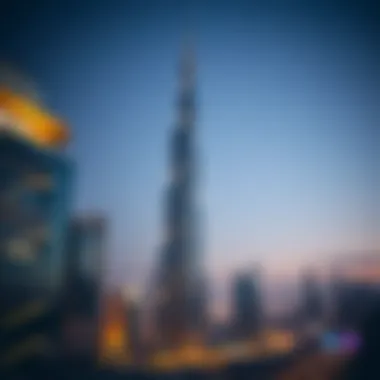
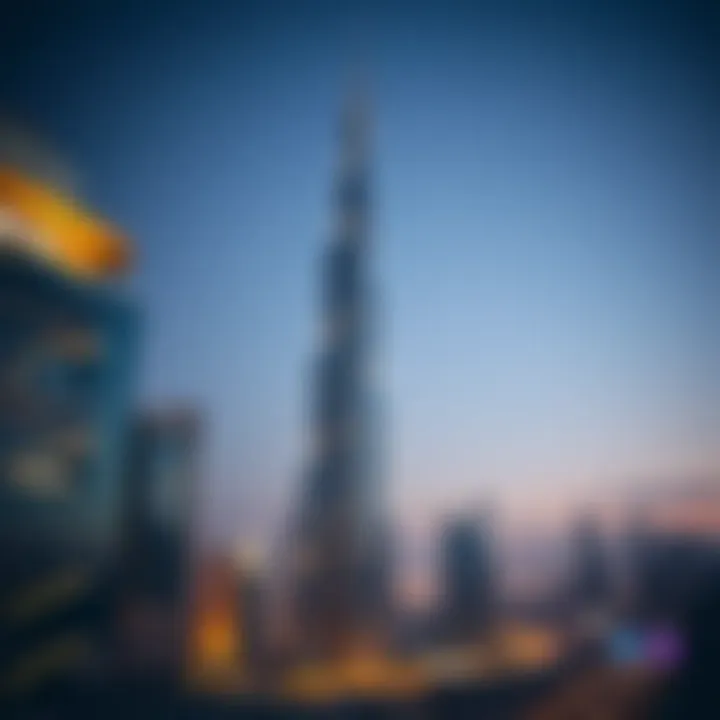
Intro
The Burj Khalifa stands as a titan among skyscrapers, its towering height a symbol of ambition and progress in the heart of Dubai. Not merely a marvel of design, it also plays a significant role in the local economy, influencing various sectors including real estate, tourism, and urban development. Understanding the Burj Khalifa’s impact requires one to delve deeper into its dimensions, architectural features, and the vibrant marketplace that thrives around this majestic structure.
In this comprehensive exploration, we will navigate the heights of the Burj Khalifa, elucidating its architectural significance while also discussing how its existence has sculpted the skyline of Dubai and affected its economy. From investment prospects to current trends in real estate, each aspect will shed light on why the Burj continues to draw global interest and investment, compelling many to turn their sights towards this towering giant.
Prolusion to Burj Khalifa
The Burj Khalifa stands as more than just the tallest building on our planet; it is a symbol of ambition and innovation. Its towering height has not only redefined the skylines of cities globally but has offered a glimpse into what human ingenuity can achieve. In this section, we will peel back the layers surrounding the Burj Khalifa, offering insights that resonate profoundly with investors, agents, buyers, sellers, and advisors alike.
Understanding the Burj Khalifa's stature and history is crucial for those involved in urban development and real estate, as it presents a myriad of opportunities and challenges. By navigating the complexities surrounding this monumental structure, readers can grasp the intricate dynamics of high-rise engineering, the architectural mindset behind it, and its impact on the economic landscape of Dubai.
Overview of Burj Khalifa
Standing at an astounding height of 828 meters, the Burj Khalifa was officially inaugurated in 2010. Designed by the architectural firm Skidmore, Owings & Merrill, its unique Y-shaped design is not just an aesthetic choice but a thoughtful engineering decision aimed at optimizing wind resistance. The structure consists of 163 floors and is adorned with over 103 floors of residential apartments, corporate suites, and a hotel. It hosts the observation deck, At the Top, which is positioned at the 148th floor, providing breathtaking views of Dubai and beyond.
The Burj Khalifa was developed as a part of a larger urban plan. It is a pivotal feature in the Downtown Dubai area, which is characterized by lavish shopping, dining, and entertainment options. The building has become an iconic attraction not just for tourists, but also for investors looking to tap into the luxurious property market that surrounds it.
Location and Accessibility
Situated in the heart of Dubai, the Burj Khalifa is easily accessible from various parts of the city. Located at 1 Sheikh Mohammed bin Rashid Boulevard, the tower is connected to the Dubai Mall, one of the largest shopping centers in the world. Visitors can reach it by multiple means of transport, including the city’s efficient metro system, taxis, or even by walking from adjacent attractions, making it a convenient destination for locals and tourists alike.
The surrounding infrastructure supports its title as a prime location; a broad network of roads and public transit options ensures that the Burj Khalifa is not just a stunning piece of architecture but also a functional hub for commerce and tourism. The connectivity of the area speaks volumes about Dubai's ambition and serves as a magnet for international investors seeking opportunities in commercial and residential properties.
"In terms of accessibility, the Burj Khalifa is a beacon of modern urban planning, seamlessly integrating with Dubai's vibrant landscape."
Height Specifications
The significance of height specifications in the context of Burj Khalifa cannot possibly be overstated. The towering structure not only represents a feat of engineering but also serves as a benchmark for architectural excellence worldwide. Understanding the height specifics affords insight into the challenges faced in its construction and the innovative approaches adopted to overcome these hurdles. Additionally, those engaged in the real estate market, tourism, and urban development can glean valuable information regarding the implications of such impressive verticality.
Total Height of Burj Khalifa
Standing at an astounding 828 meters, the Burj Khalifa holds the record for the tallest building globally. This measurement includes the building's tip, which is often a point of contention when comparing skyscrapers. The height has instilled a sense of pride in Dubai and represents the city's ambition to push architectural boundaries. For perspective, if you were to stand on the ground and gaze at its apex, you would be engaging in a visual dialogue with the very concept of human ingenuity. It's a grandeur that resonates far beyond mere numbers, merging the aspirations of a dynamic metropolis with its architectural identity.
Height Measurement Techniques
Determining the height of such a monumental structure involves multifaceted techniques that account for both vertical and horizontal measurements. Engineers initially considered a variety of methods, ranging from traditional leveling to more contemporary optical surveying techniques. One widely recognized method involves utilizing GPS technology to ensure precise measurements. Additionally, the installation of an anemometer assisted in accounting for wind influence, allowing for adjustments that kept the structure stable and safe. The interplay of technology and methodology in measuring Burj Khalifa showcases the evolution of architectural practice, adding yet another layer of fascination to the building's legacy.
Variations in Reports
The height of Burj Khalifa has been the subject of various reports and claims since its inception. Some discrepancies in height measurements often arise from differences in how the structure is quantified. For instance, certain publications might measure up to the architectural pinnacle, while others might include the height of antennae or spires. Such variations underscore the complexity in establishing a universally accepted figure for the building's height. For investors and professionals within the real estate sector, recognizing these differences is crucial, as the building's height can influence its market value and desirability among buyers. Moreover, keeping abreast of these variations allows for informed decisions and investments in a landscape where prestige and status are closely tied to architectural excellence.
Understanding the nuances of building height measurements is essential for those seeking to capitalize on or navigate the real estate opportunities highlighted by structures like the Burj Khalifa.
In summary, a thorough grasp of the height specifications of Burj Khalifa reveals not only the technical aspects behind its remarkable stature but also the broader implications it holds for architectural practice and urban development.
Architectural Design
Architectural design plays a pivotal role in any structure, particularly in the realm of skyscrapers where form meets function in ways that can redefine urban landscapes. The Burj Khalifa, as the tallest building in the world, embodies this principle to an exceptional degree. This section will delve into both the design philosophy behind Burj Khalifa and its striking architectural features, offering insights into how these elements contribute to its status not just as a building but as a cultural landmark.
Design Philosophy
The design philosophy for Burj Khalifa revolves around the concept of blending beauty with engineering prowess. The vision was clear: to create a structure that stands as a beacon of innovation and elegance. The chief architect, Adrian Smith, drew inspiration from the * Hymenocallis*, a local desert flower, which is reflected in the building’s soaring, Y-shaped profile.
Moreover, the building’s design isn’t just skin-deep. The structure incorporates a series of setbacks, meaning it gradually reduces in width as it ascends. This not only provides aesthetic appeal but also enhances its structural integrity against harsh winds—an essential consideration in tall buildings. Some might say it reflects a kind of dance with nature, where the architecture honors both the environment and the human spirit.
"The Burj Khalifa pushes the boundaries of what is possible, creating new standards in both engineering and design."
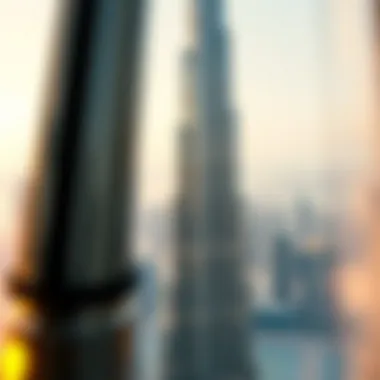
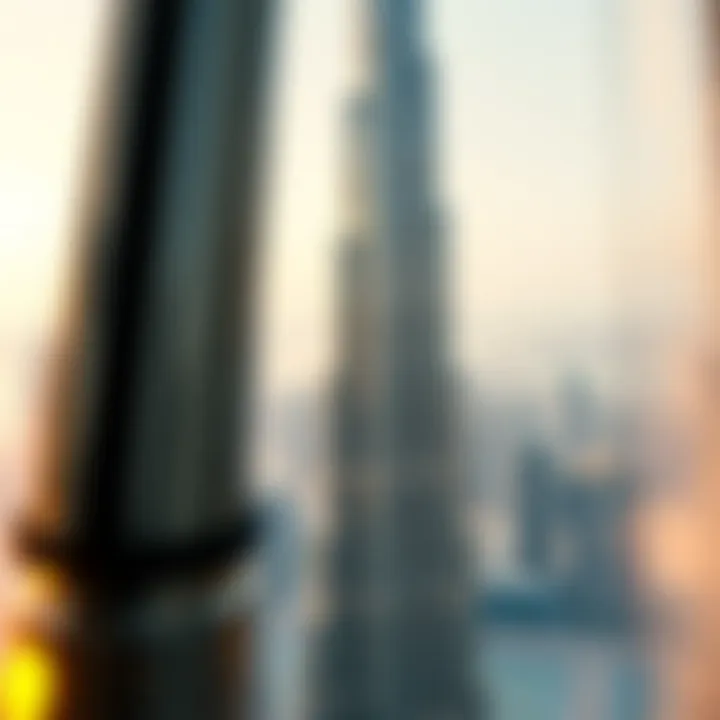
Another element of the philosophy is sustainability. The designers aimed to incorporate energy-efficient systems to minimize the building’s ecological footprint. Each aspect—from the reflective glass facade to the chilling systems—is meticulously planned to align with modern environmental standards while maximizing comfort for its occupants.
Architectural Features
When it comes to architectural features, Burj Khalifa leaves little to the imagination. There are various elements that stand out, making the building not just a feat of engineering but an embodiment of luxury and style:
- The Exterior: The façade of the Burj Khalifa is covered with more than 103,000 square meters of glass. This reflective surface not only provides breathtaking views but also helps regulate temperature inside, reducing the reliance on air conditioning.
- Observation Decks: The building houses multiple observation decks, with the most famous being At the Top, Burj Khalifa Sky, located on the 148th floor. Visitors are treated to panoramic views of Dubai that pull the city together in a stunning visual tapestry.
- Unique Lighting Systems: The building is equipped with sophisticated lighting technology that allows for spectacular light shows, further accentuating its height and form against the Dubai skyline at night. These light displays can reflect cultural occasions, adding a dynamic element to what is otherwise a static structure.
- Public Spaces: Within its walls, Burj Khalifa hosts a variety of public spaces, including luxurious lounges, high-end restaurants, and landscaped gardens that create an inviting atmosphere. This blending of private and public zones showcases how architectural design can cater to diverse needs.
In summary, the architectural design of Burj Khalifa encompasses more than just its striking height. It captures the essence of Dubai’s aspiration through its design philosophy and detailed features, echoing a commitment to innovation, sustainability, and beauty. As we explore the construction journey next, we will unravel how these elements materialized into reality, marking another chapter in the story of this monumental structure.
Construction Journey
The journey of constructing Burj Khalifa is nothing short of remarkable. A story that embodies vision, ambition, and engineering ingenuity, it’s an essential chapter in understanding not only this skyscraper's status but also the evolution of modern architecture. The construction process not only highlights the scale at which human creativity can operate but also speaks volumes about the investments and innovations that go into building such an iconic structure.
From the first scoop of earth to the final touches that gave it its sleek façade, every phase of the construction journey contributed to Burj Khalifa’s height and grandeur. It stands as a testament to what can be achieved when decisive planning meets cutting-edge technology. In the context of Dubai's rapid development, the Burj Khalifa marked a turning point, reshaping both the city’s skyline and its economic landscape.
Timeline of Construction
The Burj Khalifa's construction commenced in 2004, and what followed was a detailed orchestration of labor, materials, and timelines that required meticulous attention to detail.
- 2004: Ground was broken and excavation began, revealing the geological marvels beneath the city.
- 2005: The core of the skyscraper was started, setting the stage for the structure that would ascend to record heights.
- 2007: By this time, the building reached its impressive height of 512 meters, and the exterior was starting to take shape, drawing admiration.
- 2009: The towers of Burj Khalifa officially reached its peak at 828 meters, becoming the tallest building in the world.
- 2010: On January 4, the grand opening ceremony took place, revealing a dazzling display of fireworks and light shows that dazzled visitors.
The project thrived on thorough planning, efficient use of resources, and the collaboration of thousands of skilled workers from around the globe. Each phase saw adjustments made, tightening timelines, and increasing pressures, but ultimately showcased how solid governance can help navigate through challenges.
Engineering Innovations
Burj Khalifa is often regarded as a marvel not just for its height but also for the innovative engineering techniques that drove its construction. Here are some notable engineering feats:
- Reinforced Concrete: Utilizing advanced concrete mixes allowed for a sturdy yet lightweight structure, capable of withstanding the harsh desert elements.
- Wind Tunnel Testing: Engineers had the foresight to employ wind tunnel simulations to understand how the building would interact with the environment, steering design choices to enhance stability.
- High-Performance Elevator Systems: Burj Khalifa features blistering-fast elevators that travel at speeds reaching up to 10 meters per second, underscoring engineering prowess.
"The Burj Khalifa isn’t just another building; it's a symbol of human ambition and engineering prowess, fully optimized for its environment."
In summary, the construction journey of Burj Khalifa encapsulates the significance of cooperative efforts and cutting-edge engineering. This skyscraper's design and build could not have been achieved without the fusion of global expertise, resource integration, and immense financial backing. Looking at its towering form against the Dubai skyline, one can appreciate the labor and innovation infused throughout every stage of its construction.
Impact on Dubai's Skyline
The Burj Khalifa is not merely a skyscraper; it has become an emblem of Dubai’s rapid transformation and urban ambition. Its towering presence reshapes the city’s landscape, affecting how both residents and visitors perceive Dubai. The building's existence extends beyond height; it represents a shift in architectural thinking and urban development. As it reaches into the clouds, it beckons not just admiration but also complex socio-economic dynamics.
Iconic Status
When you mention iconic buildings, Burj Khalifa undoubtedly jumps to the forefront. Its striking silhouette dominates the skyline, influencing architectural trends around the world. Standing at 828 meters, it eclipses other tall structures, establishing a new benchmark in skyscraper design. This iconic status has given rise to a global identity for Dubai, positioning it as a must-see destination.
The Burj Khalifa symbolizes Dubai's ambition, reflecting its ability to dream big. Even the building’s design draws elements from traditional Islamic architecture, marrying cultural heritage with modern engineering, showcasing that innovation need not erase cultural identity. For instance, the Y-shaped footprint of the Burj is intended to maximize views of the surrounding landscape, a thoughtful nod to its environment.
As a result, tourism flourishes. The Burj Khalifa attracts millions annually, offering breathtaking views from its observation decks. This influx of visitors not only bolsters local businesses but also enriches the cultural tapestry of Dubai. It feels like an anchor around which the city’s life spins. The iconic nature of Burj Khalifa also plays a significant role in media representation, making it a regular feature in films and advertisements, further embedding it into the world’s consciousness.
Influence on Urban Development
Burj Khalifa has indirectly sparked significant urban development throughout Dubai. Its construction and the surrounding developments have catalyzed a surge in investment, underscoring its influence on the real estate market. The mixed-use platform at its base includes residential, commercial, and retail spaces that seamlessly integrate with surrounding areas, creating a bustling urban hub.
This integration also highlights a crucial element of modern urban design: walkability. The connectivity provided by the Burj necessitated real infrastructure improvements, leading to enhanced public transport links and pedestrian-friendly areas. Developers have followed suit, resulting in a plethora of projects that mirror the Burj's grandeur and ambition.
Furthermore, Burj Khalifa has spurred the development of other towers, both in Dubai and around the globe. Projects have emerged aiming to rival its status, leading to what can be seen as a new race in tall building construction. This has not only reinforced Dubai as a key player in global urbanism but also raised the stakes in architectural innovation.
To illustrate how the influence of Burj Khalifa extends:
- Increased foot traffic has led to the development of luxury shopping complexes nearby.
- It has fueled growth in hospitality, with high-end hotels catering to the influx of tourists.
- The surrounding parks and recreational areas have benefitted from enhanced planning, focusing on leisure and community gatherings.
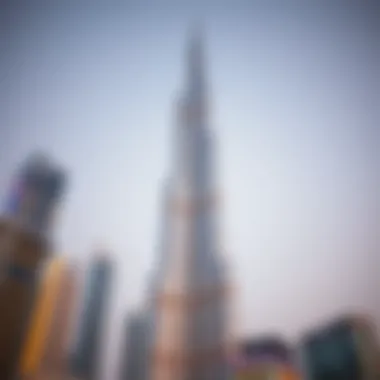
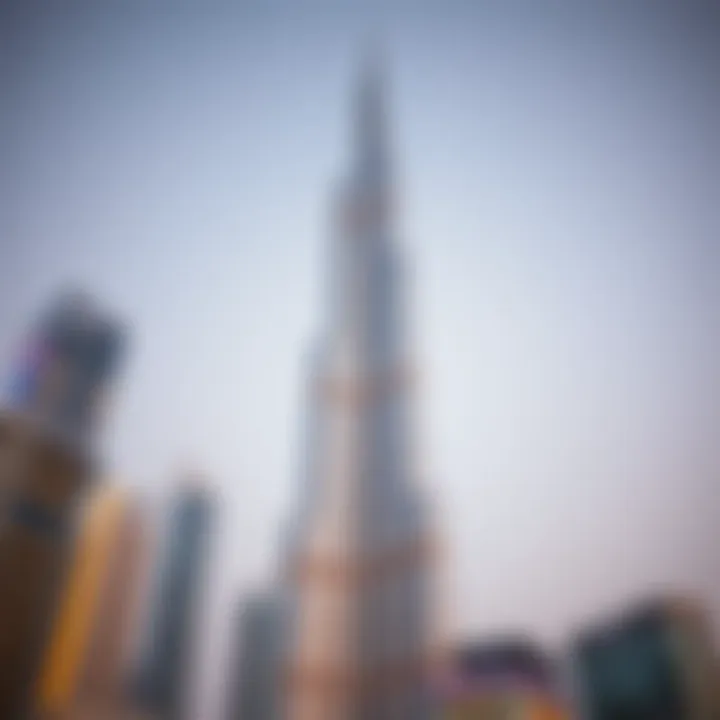
“The Burj Khalifa does not only touch the skies; it also shapes the ground beneath it, prompting a blueprint for modern urban living.”
In summation, the Burj Khalifa stands as more than just an architectural triumph; it reigns as a beacon of urban renewal and economic growth. Its iconic stature inspires global architectural trends while reshaping Dubai's urban landscape and real estate market, thereby sealing its place at the heart of Dubai’s continued evolution.
Burj Khalifa's Role in Real Estate
The Burj Khalifa stands as a towering symbol, not just of engineering marvel but also of significant economic influence within Dubai's real estate sector. Its towering presence has escalated property values in its immediate vicinity and across Dubai, redefining the landscape of luxury living and commercial investment. The building does more than scrape the sky; it plays a pivotal role in shaping the real estate dynamics of the region.
Real Estate Market Trends
The rise of Burj Khalifa has been intertwined with a multitude of market trends in the real estate sector. To begin with, properties near the Burj have seen an upward trend in pricing, with many buyers eager to own a piece of the prestigious neighborhood. The allure of living close to such an iconic structure amplifies demand significantly.
- Luxury Residences: Units with breathtaking views of the Burj Khalifa command a premium. Anyone with an eye for investments knows that homes with such prestigious neighbors sell faster and for better prices.
- Commercial Properties: Businesses flock to the area, resulting in a boost in demand for office spaces. Companies vie for office locations that grant employees views of this architectural masterpiece.
- Tourism Impact: As a global tourist hotspot, properties that cater to tourists, like hotels and short-term rental apartments, have thrived. Increased foot traffic in the area contributes directly to the profitability of the hospitality sector.
Real estate experts have noted a more pronounced trend where investors seek out properties that provide not just a roof over their heads but an experience linked intrinsically with the Burj Khalifa brand. Overall, the tower's presence has catalyzed local and international investments, changing perceptions about Dubai as a real estate hub.
Investment Opportunities
Investing in real estate around Burj Khalifa offers a multitude of opportunities, bringing together luxury and strategic investment.
- High Demand for Rentals: Given its status, properties near the Burj enjoy high rental yields. Investors frequently find that leasing rates can catch a solid uptick, especially in residential units.
- Commercial Ventures: Investing in commercial real estate, such as retail spaces or coworking hubs, promises substantial returns. Given the amount of foot traffic from tourists and local residents alike, businesses here stand to benefit.
- Mixed-Use Developments: The trend toward multimodal developments that incorporate living, working, and leisure spaces is becoming more attractive. Investors notice that properties fusing these features near the Burj are drawing greater interest.
"The Burj Khalifa is not just a building; it's a catalyst for economic growth and transformation in Dubai's real estate landscape."
The demand in these sectors signals robust growth potential. Individuals interested in capitalizing on the shifting market can see significant returns while contributing to the economic vitality of Dubai. Careful assessment of these investment avenues, aligned with real trends around Burj Khalifa, presents a golden opportunity in a thriving market.
Tourism and Visitor Experience
Tourism plays a pivotal role in the overall impact of the Burj Khalifa, elevating not only its profile but also Dubai's status on the global stage. This towering marvel attracts millions of visitors each year, contributing substantially to the local economy and cultural landscape. Understanding the visitor experience is crucial for potential investors, real estate agents, and developers who see the value in this iconic structure, both as a landmark and as a hub of activity.
Attractions within Burj Khalifa
The attractions within Burj Khalifa create an unparalleled experience, making it a must-visit destination. First and foremost, the observation decks, At the Top, Burj Khalifa, located on the 124th and 148th floors, offer breathtaking panoramic views of the cityscape, stretching all the way to the horizon. Visitors revel in the chance to gaze down upon the winding waterways, sprawling deserts, and emerging architectural delights that mark the Dubai skyline.
Additionally, the Atmosphere Restaurant, situated on the 122nd floor, provides a luxurious dining experience unlike any other. Patrons enjoy gourmet meals while taking in views that few can rival. The grandeur of the sunset as it paints the city golden is something to behold.
Moreover, interactive exhibits within the building educate visitors about its construction and the technology utilized to build such a colossal structure. These attractions not only engage the curious mind but also help to cement Burj Khalifa's place as a cornerstone of modern engineering.
- Observation Decks
- Atmosphere Restaurant
- Interactive Exhibits
"Each visit is a leap into the sky, and every glance grants a new perspective of the world below."
The blend of thrilling experiences and educational components makes Burj Khalifa not just a sightseeing opportunity but an immersive journey that resonates with visitors long after they’ve left its premises.
Visitor Statistics
Visitor statistics provide a fascinating insight into Burj Khalifa's role as a tourist magnet. In recent years, the building has welcomed approximately 1.5 million visitors annually to its observation decks alone. Most of these guests are international tourists, drawn to the allure of the tallest structure in the world. The broad spectrum of visitors—ranging from families seeking memorable experiences to architects and engineers interested in its design—illustrates the building’s diverse appeal.
Furthermore, peak visiting times often correlate with major holidays and events in Dubai. Special events, such as New Year celebrations, attract even larger crowds, affirming the Burj Khalifa's significance as a focal point of festivities. This surge in visitors creates increase in demand for surrounding amenities, including hotels, restaurants, and transportation services, benefiting the broader economic ecosystem.
Some other notable statistics include:
- Average daily visitors: 5,000-7,000
- Best months for visitation: December (due to the holidays) and April (optimal weather conditions)
Understanding these patterns equips stakeholders with the insight needed to maximize opportunities surrounding this landmark. Therefore, tourism and visitor experience are not just about numbers. They represent a broader canvas showcasing the cultural, economic, and architectural significance of the Burj Khalifa.
Cultural Significance
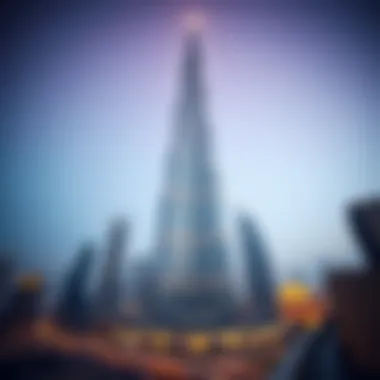
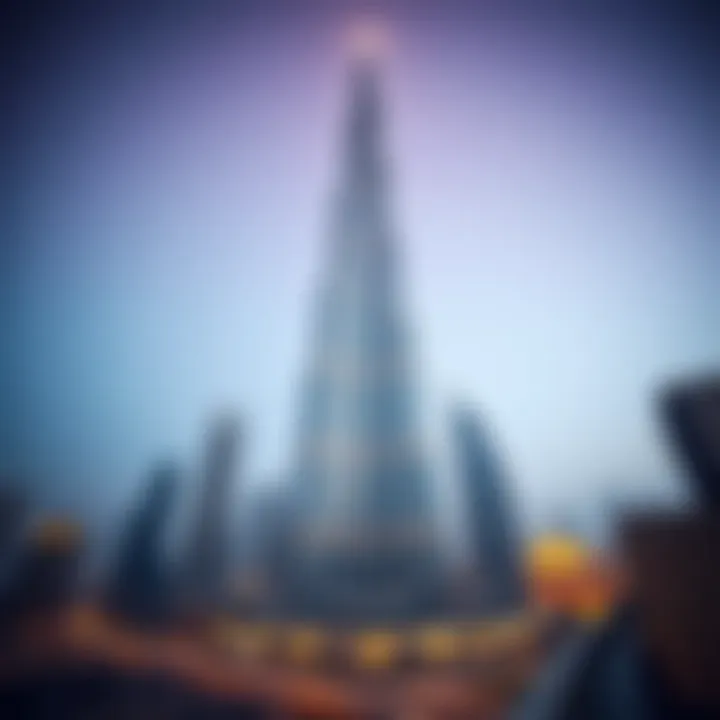
The cultural significance of Burj Khalifa extends far beyond its impressive height. As a landmark, it symbolizes not just architectural ambition but also the spirit of innovation that characterizes Dubai. This towering structure has become a national icon, representing a narrative where dreams transform into reality, pushing the boundaries of human creativity and determination.
Symbol of Progress
Burj Khalifa stands tall as a beacon of progress, showcasing the aspirations of an entire nation. Constructed amid economic uncertainty in the early 2000s, its completion in 2010 marked a pivotal moment in Dubai's transformation from a small trading port to a global metropolis. It serves as a reflection of the city’s extensive investments in infrastructure and development, which aimed to diversify its economy beyond oil dependency.
This skyscraper is not merely a feat of engineering; it embodies the vision for a future where innovation and modernization can thrive. The design, inspired by traditional Islamic architecture, integrates cutting-edge technology while respecting cultural heritage. In this sense, Burj Khalifa is more than a building; it is an unfinished story of progress that continues to inspire generations.
"Burj Khalifa is a symbol of determination—a reminder that we can overcome obstacles and reach for the sky."
Representation in Media
The influence of Burj Khalifa stretches into the cultural realm through various forms of media. It has become a frequent subject in films, television shows, and even literature, often depicted as a symbol of opulence and modernity. Movies like "Mission: Impossible – Ghost Protocol" featured powerful scenes shot on its rooftops, solidifying its status as an international attraction.
Social media platforms showcase countless images and experiences of visitors, providing a glimpse into not just the view from the top but the lifestyle that surrounds it. The building has instigated a dialogue about urban living and sustainability, contributing to a broader conversation about how future cities will coexist with nature while pursuing ambitious architectural projects.
Moreover, local artists and photographers often depict Burj Khalifa in their works, using it as a canvas to express personal stories or societal themes. Hence, it becomes a cultural touchstone, demonstrating how architecture can shape identity and connect communities on both local and global scales.
In essence, Burj Khalifa is far more than an architectural marvel; it serves as a symbol of hope and ambition, portrayed in myriad ways throughout media. The narratives it generates resonate well with investors, agents, buyers, and sellers, representing not just a quest for height but for a greater purpose in urban development.
Future Trends in Architecture
The architectural landscape has been evolving rapidly, driven by technological advances, sustainability concerns, and the increasing desire for aesthetic innovation. In this exploration of Burj Khalifa, one can hardly ignore how this towering structure not only defines the skyline of Dubai but also serves as a beacon for future architectural endeavors. The need to create spaces that are not only visually stunning but also environmentally conscious has become paramount.
Inspiration from Burj Khalifa
Burj Khalifa looks like it’s reaching for the stars, and in a way, it inspires architects around the globe to think beyond limits. The building showcases a blend of artistry and engineering prowess, demanding an evolution in architectural practices.
- Vertical Expansion: Tall buildings like Burj Khalifa push the boundaries of height potential. Architects are increasingly drawn to verticality, emphasizing the importance of building up efficiently while utilizing limited ground space.
- Sustainable Features: With each new project, the integration of green design elements becomes essential. Burj Khalifa is equipped with cutting-edge technologies that significantly reduce its environmental footprint. Designers are now exploring similarly innovative materials and systems to follow suit.
- Cultural Reflection: The unique structure symbolizes the heritage and aspirations of the region. As architects look to draw inspiration from their own cultures, they are finding ways to integrate local tradition with modern design, much like Burj Khalifa does with Islamic architectural elements.
These influences are opening doors to new possibilities, showcasing that the past can blend seamlessly with the future. The Burj Khalifa stands as an enduring benchmark against which future projects will be measured, urging architects to dream big and aim for lofty ideals.
Innovations in Tall Building Design
As the world continues to embrace rapid urbanization, the evolution of tall building design is paramount. The advancements catalyzed by projects like Burj Khalifa are setting a new gold standard.
- Smart Building Technologies: High-rise buildings are now incorporating intelligent systems that enhance energy efficiency and comfort. For instance, Burj Khalifa utilizes a complex array of sensors and data analytics for optimized operations and resource management.
- Wind Engineering Solutions: The wind tunnel testing used during Burj Khalifa's design has led to significant innovations in aerodynamics for skyscrapers. Future designs incorporate these lessons to withstand nature's forces gracefully while offering aesthetic charm.
- Modular Construction Techniques: Increasingly, architects are looking into modular designs that expedite the construction process without compromising quality. Burj Khalifa has influenced this approach, paving the way for prefabricated elements to be assembled at great heights.
“The Burj Khalifa isn’t just a building; it’s a daring leap of faith into what the future can hold in architectural design.”
Such innovations are critical in defining the future of architecture, addressing both the challenges of environmental sustainability and the demands of growing urban populations. Architects and engineers are diving headfirst into developing structures that are not just sky-high, but also thoughtful representations of how humans can coexist harmoniously with the environment.
As one reflects on these trends and inspirations, it becomes clear that the legacy of Burj Khalifa will resonate deeply in architectural discourses, influencing not only how we build but also how we think about the spaces we inhabit.
Finale
Summary of Key Points
In this article, we have traversed the towering heights and intricate details behind the Burj Khalifa, cementing its position as an architectural wonder. From its staggering total height of 828 meters to the innovative techniques used in its construction, the Burj Khalifa is not just a building; it is a statement of ambition and human ingenuity. The discussion ranged from the architectural features that define its unique aesthetic to its undeniable impact on Dubai's skyline and economy. Key takeaways include:
- Height Specifications: The building’s height, achieved through advanced engineering and design, stands as a testament to modern construction capabilities.
- Architectural Design: The building’s design reflects not just beauty but also functionality, utilizing local materials and sustainable methods.
- Impact on Tourism and Real Estate: Burj Khalifa plays a vital role in Dubai’s real estate market, boosting tourism and investment opportunities.
These points coalesce to illustrate the Burj Khalifa as a pivotal point of reference in discussions around modern architecture and urban development.
Final Thoughts
Reflecting on the significance of the Burj Khalifa, it is clear that its influence extends beyond mere height. This skyscraper has become a symbol of Dubai’s rapid growth and global aspirations. Future architectural projects may draw inspiration from its innovative approaches, further pushing the bounds of what is possible in construction. Investors and stakeholders in the real estate market must consider how such iconic structures shape urban landscapes and drive economic activity.
In essence, the Burj Khalifa is more than just a tall building; it embodies a vision of progress, ambition, and the relentless pursuit of the extraordinary. As we look ahead, it will be fascinating to see how future developments in architecture continue to rise to meet the challenge set by this formidable titan of glass and steel.
"The Burj Khalifa not only defines the horizon of Dubai but also challenges the sky itself."
To explore more about the Burj Khalifa, consider visiting The Official Burj Khalifa Website or reading insights from Britannica for additional information.















